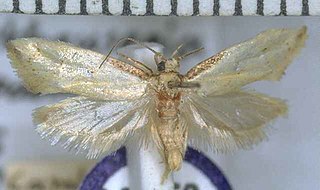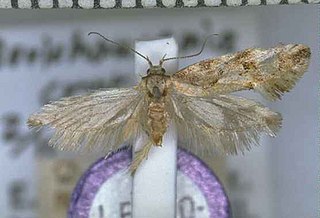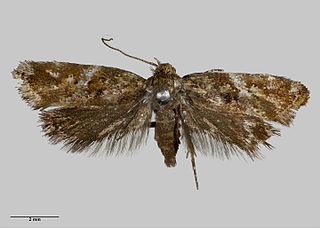
Erechthias chionodira is a species of moth of the family Tineidae. It was first described by Edward Meyrick in 1880. This species is endemic to New Zealand and has been observed on both the North and South Islands. E. chionodira inhabits native forest. Larvae likely feed on dead plant debris or on the tough leaves of plants such as flax. Adults are on the wing from September until February. During the day they can be seen at rest on tree trunks or fences. Adults are attracted to light.

Amblyptilia epotis is a moth of the family Pterophoridae. It is endemic to New Zealand and is found in the South and Stewart Islands. It inhabits mountainous terrain covered in alpine vegetation or alternatively alpine wetland habitat. The adults of this species are on the wing from February to March. In appearance the adults of this species are variable in colour however this species can be distinguished from similar species by the oblique apical streak on its forewings as well as the patch of white on the costa cilia towards the apex of the forewing.

Pyroderces aellotricha, also known as the Cosmet moth, is a moth of the family Cosmopterigidae. It is found in New Zealand, in Australia and the Cook Islands.

Erechthias acrodina is a species of moth of the family Tineidae. This species was first described by Edward Meyrick. It is endemic to New Zealand and is found in the North, South and the Chatham Islands. This species inhabits native forest often near Phormium species and have also been observed on dead Leptospermum scrub. Larvae has been reared from decaying Phormium leaves. Adults are on the wing from October to February.

Erechthias chasmatias is a species of moth in the family Tineidae. It was first described by Edward Meyrick in 1880. This species is endemic to New Zealand and is found in the North Island. This species inhabits native bush. Adults are on the wing from October to April and have been collected by beating small trees and foliage.

Erechthias crypsimima is a species of moth in the family Tineidae. It was described by Edward Meyrick in 1920. This species is endemic to New Zealand and has been observed in the North Island. This species inhabits native forest and has been observed in Nothofagus fusca forest. The larvae likely feed on either deceased plant detritus or tough leaves of plants such as palms or flax. Adults are on the wing commonly from January to March. During the day adults are known to rest of tree trunks where the moth's colouration helps provide protection by camouflaging the moth.

Erechthias exospila is a species of moth of the family Tineidae. It was first described by Edward Meyrick in 1901. It is endemic to New Zealand and can be found in the North Island as well as the Poor Knights and D'Urville Islands. This species inhabits native forest. Larvae of species in the genus Erechthias feed on dead plant debris or the tough leaves of plants such as palms. E. exospila frequents the dead leaves of Astelia. Adults have been observed in November and February. Specimens of this species have been collected via malaise trap and beating shrubs.

Erechthias hemiclistra is a species of moth of the family Tineidae. It was first described by Edward Meyrick in 1911. This species is endemic to New Zealand and has been observed in both the North and South Islands. This species inhabits native forest and have an affinity for species in the genera Phormium,Cortaderia and Cordyline likely as a result of the larvae of this species feeding on dead fibre sourced from species in these genera. Adults are on the wing from September to April but are most commonly observed in December and January. Adults are attracted to light.

Erechthias macrozyga is a species of moth of the family Tineidae. It was described by Edward Meyrick in 1916. This species is endemic to New Zealand and has been observed in the North and South Islands. This species inhabits lowland native forest. Adult moths are on the wing from October to February.

Sagephora felix is a species of moth in the family Tineidae. It was described by Edward Meyrick in 1914. This species is endemic to New Zealand and can be found in the north half of the North Island. It inhabits native forest and adults of the species are on the wing from December to May, in July and November.

Tingena anaema is a species of moth in the family Oecophoridae. It is endemic to New Zealand and has been collected at Lake Wakatipu, Invercargill and Stewart Island / Rakiura. The adults of the species are on the wing in December.

Tingena apanthes is a species of moth in the family Oecophoridae. It is endemic to New Zealand and found on the North Island. The adults are on the wing from October to December. It appears associated with Leptospermum species and it has been hypothesised that the appearance of the adults of this species imitates faded Leptospermum leaves.

Tingena chloritis is a species of moth in the family Oecophoridae. It is endemic to New Zealand and has been found in the South Island. Larvae of this species feed on leaf litter. The adults of this species are light flyers and are attracted to light.

Tingena crotala is a species of moth in the family Oecophoridae. It is endemic to New Zealand and is found both in the North and South Islands. This species inhabits native forest and is on the wing in November and December.

Tingena eumenopa is a species of moth in the family Oecophoridae. It is endemic to New Zealand and found in the North and South Islands. The adults have been found amongst tree ferns and are on the wing in December.

Tingena hemimochla is a species of moth in the family Oecophoridae. It is endemic to New Zealand and has been observed in the North Island. Adults of this species are on the wing from December until March.

Tingena horaea is a species of moth in the family Oecophoridae. It is endemic to New Zealand and have been observed in both the North and South Islands. The adults are on the wing in January.

Tingena pronephela is a species of moth in the family Oecophoridae. It is endemic to New Zealand and is found in the southern parts of the South Island. The species inhabits the outskirts of scrub and native forest. The adults of this species are on the wing from October to February.

Atomotricha sordida is a moth in the family Oecophoridae first described by Arthur Gardiner Butler in 1877. It is endemic to New Zealand and has been observed in the South Island in the Canterbury and Otago regions. The adult female of the species is brachypterous.

Trachypepla protochlora is a moth of the family Oecophoridae first described by Edward Meyrick in 1883. It is endemic to New Zealand and is found in both the North and South Islands. The preferred habitat of this species is native forest and adults are on the wing from October until February. Adults can be variable in their green shaded colour as well as in the intensity of markings on their forewings. The greenish ground colouration of this moth ensures they are well camouflaged when at rest on green mosses and lichens.






















